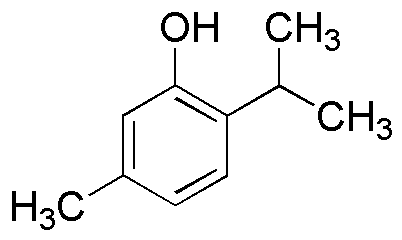Thymol is widely utilized in research focused on:
- Antimicrobial Applications: Thymol is known for its strong antibacterial and antifungal properties, making it valuable in the formulation of disinfectants and antiseptics used in healthcare settings.
- Aromatherapy and Essential Oils: As a key component of thyme oil, thymol is used in aromatherapy for its calming effects and is popular in the production of natural fragrances and essential oils.
- Food Preservation: Its natural preservative qualities help inhibit the growth of spoilage microorganisms, making thymol a preferred choice in the food industry for extending shelf life and ensuring food safety.
- Pest Control: Thymol serves as an effective, eco-friendly insect repellent and is incorporated into organic pest control products, appealing to environmentally conscious consumers.
- Pharmaceuticals: In medicinal chemistry, thymol is explored for its potential therapeutic effects, including anti-inflammatory and antioxidant properties, contributing to the development of new health supplements.
General Information
Properties
Safety and Regulations
Applications
Thymol is widely utilized in research focused on:
- Antimicrobial Applications: Thymol is known for its strong antibacterial and antifungal properties, making it valuable in the formulation of disinfectants and antiseptics used in healthcare settings.
- Aromatherapy and Essential Oils: As a key component of thyme oil, thymol is used in aromatherapy for its calming effects and is popular in the production of natural fragrances and essential oils.
- Food Preservation: Its natural preservative qualities help inhibit the growth of spoilage microorganisms, making thymol a preferred choice in the food industry for extending shelf life and ensuring food safety.
- Pest Control: Thymol serves as an effective, eco-friendly insect repellent and is incorporated into organic pest control products, appealing to environmentally conscious consumers.
- Pharmaceuticals: In medicinal chemistry, thymol is explored for its potential therapeutic effects, including anti-inflammatory and antioxidant properties, contributing to the development of new health supplements.
Documents
Safety Data Sheets (SDS)
The SDS provides comprehensive safety information on handling, storage, and disposal of the product.
Product Specification (PS)
The PS provides a comprehensive breakdown of the product’s properties, including chemical composition, physical state, purity, and storage requirements. It also details acceptable quality ranges and the product's intended applications.
Certificates of Analysis (COA)
Search for Certificates of Analysis (COA) by entering the products Lot Number. Lot and Batch Numbers can be found on a product’s label following the words ‘Lot’ or ‘Batch’.
*Catalog Number
*Lot Number
Certificates Of Origin (COO)
This COO confirms the country where the product was manufactured, and also details the materials and components used in it and whether it is derived from natural, synthetic, or other specific sources. This certificate may be required for customs, trade, and regulatory compliance.
*Catalog Number
*Lot Number
Safety Data Sheets (SDS)
The SDS provides comprehensive safety information on handling, storage, and disposal of the product.
DownloadProduct Specification (PS)
The PS provides a comprehensive breakdown of the product’s properties, including chemical composition, physical state, purity, and storage requirements. It also details acceptable quality ranges and the product's intended applications.
DownloadCertificates of Analysis (COA)
Search for Certificates of Analysis (COA) by entering the products Lot Number. Lot and Batch Numbers can be found on a product’s label following the words ‘Lot’ or ‘Batch’.
*Catalog Number
*Lot Number
Certificates Of Origin (COO)
This COO confirms the country where the product was manufactured, and also details the materials and components used in it and whether it is derived from natural, synthetic, or other specific sources. This certificate may be required for customs, trade, and regulatory compliance.


